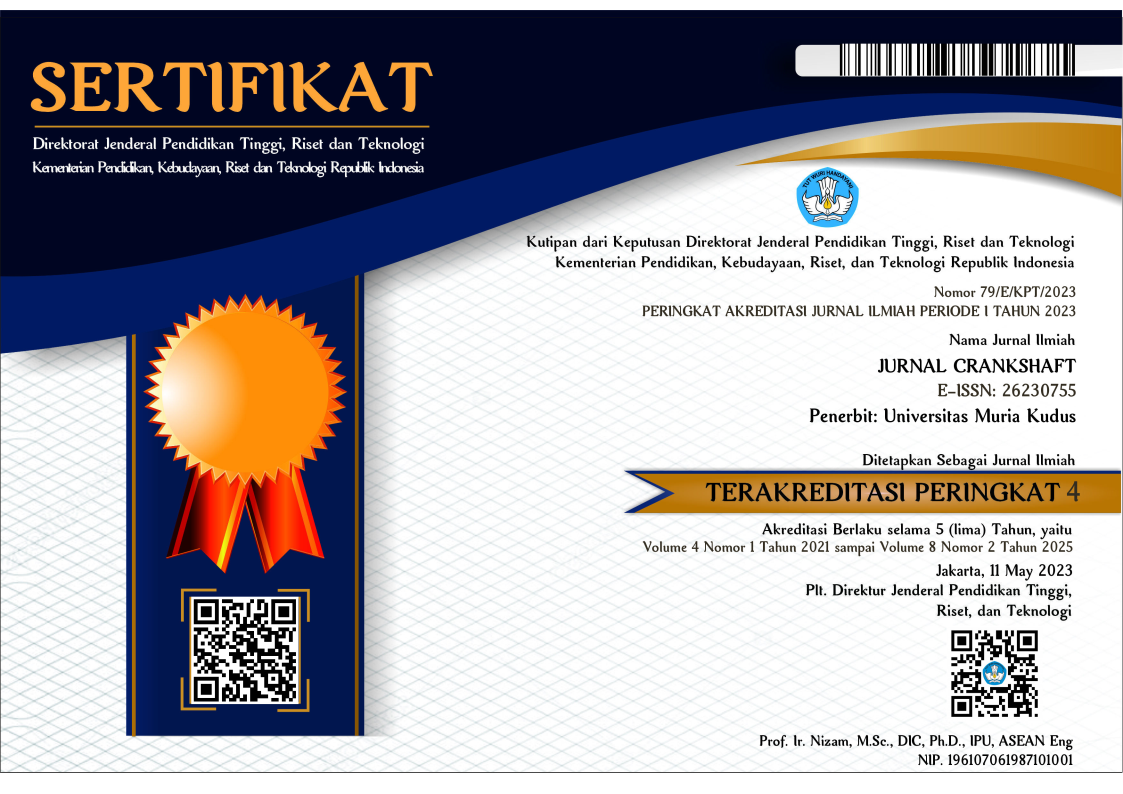Analisis Kekuatan Fishing Tools Holder 50.000 lbs menggunakan Metode Finite Element
Sari
Finite element numerical simulation (FEA) has a function to analyze the design model and as a validation of the analysis results against manual calculations. FEA simulation uses specialized software to save time and cost. The purpose of the FEA simulation on this design model is to analyze the strength of the design model against a deformation. In this study, a strength test will be carried out on one of the sub-assemblies on the fishing equipment tensile and compressive testing machine, namely the fishing tools holder sub-assembly. The reason for the simulation is that the sub-assembly is directly related to compressive or tensile forces with relatively large units. The material used for this sub-assembly design is SS400 material or ASTM A36 Carbon Steel. The simulation process was carried out in 10 iterations using the curvature-based mesh method with mesh size settings of 10, 9, 8, 7, 6, 5.8, 5.6, 5.4, 5.2, and 5. The maximum stresses that occurred and reached convergence were at mesh sizes 5.8, 5.6, 5.4, and 5.2 in sequence with stress values of 137 MPa, 136 MPa, 142 MPa, and 135.7 MPa, respectively. The finite element analysis results show that the fishing tools holder design produces a maximum stress of 142 MPa at the converging area, with a factor of safety (FoS) of 1.8. Based on these simulations, the design of the fishing tools holder can be implemented on the Fishing Equipments Tensile Test and Press Test Machine.
Kata Kunci
Teks Lengkap:
PDFReferensi
[1] A. F. Mohamed, “Finite Element Analysis for Stresses in Thin-Walled Pressurized Steel Cylinders,” Int. J. Sci. Eng. Res., vol. 9, no. 3, 2018, [Online]. Available: http://www.ijser.org
[2] M. M. Ali and M. M. Khalifa, “Effects of Welding Parameters on Characterization and Mechanical Properties of Steel 37 Weldments,” JES. J. Eng. Sci., vol. 48, no. 2, pp. 212–221, 2020, doi: 10.21608/jesaun.2020.188012.
[3] G. F. O. Ferreira, M. L. Ribeiro, A. J. M. Ferreira, and V. Tita, “Computational analyses of composite plates under low-velocity impact loading,” Mater. Today Proc., vol. 8, no. April, pp. 778–788,2019, doi: 10.1016/j.matpr.2019.02.020.
[4] . K. M., “Dynamic Analysis of Laminated Composite Plates,” Int. J. Res. Eng. Technol., vol. 04, no.25, pp. 116–121, 2015, doi: 10.15623/ijret.2015.0425018.
[5] A. Remennikov, T. Ngo, D. Mohotti, B. Uy, and M. Netherton, “Reprint of: Experimental investigation and simplified modeling of response of steel plates subjected to close-in blast loading from spherical liquid explosive charges,” Int. J. Impact Eng., vol. 105, no. May, pp. 1–12, 2017, doi: 10.1016/j.ijimpeng.2017.03.024.
[6] M. Bhandari, “Analysis of Functionally Graded Material Plate under Transverse Load for Various Boundary Conditions,” IOSR J. Mech. Civ. Eng., vol. 10, no. 5, pp. 46–55, 2013, doi: 10.9790/1684-1054655.
[7] N. S. M. Nasir, M. K. A. A. Razab, S. Mamat, and M. I. Ahmad, “Review on Welding Residual Stress,” ARPN J. Eng. Appl. Sci., vol. 11, no. 9, pp. 6166–6175, 2016.
[8] S. J. Vaghela and S. Kumanan, “Finite Element Analyis of Submerged Arc Welding,” no. January 2014, 2013.
[9] J. W. H. Price, A. M. Pardowska, R. Ibrahim, and T. R. Finlayson, “Residual stresses evaluation in welds and implications for design for pressure vessel applications,” J. Press. Vessel Technol. Trans. ASME, vol. 128, no. 4, pp. 638–643, 2006, doi: 10.1115/1.2349577.
[10] V. Eswara, D. V. N. J. Jaggannadha Rao, and Y. Seetharama Rao, “Finite element simulation of residual stresses in welded steel butt joints and their experimental verification and mitigation,” IOP Conf. Ser. Mater. Sci. Eng., vol. 1168, no. 1, p. 012020, 2021, doi: 10.1088/1757-899x/1168/1/012020.
[11] Abambres, M. & Arruda, M. (2016). Finite Element Analysis of Steel Structures – A Review of Useful Guidelines. International Journal of Structural Integrity. Vol.7, No.8, pp.490-515 201.
[12] Dutt, A. (2015). Effect of Mesh Size on Finite Element Analysis of Beam. SSRG International Journal of Mechanical Engineering (SSRG-IJME) – volume 2 Issue 12 – December 2015.
[13] Liu, Y. (2013). Choose the best element size to yield accurate FEA results while reduce FE model’s complexity, British Journal of Engineering and Technology, Vol.1, No.7, pp13-28.
[14] C. M. Wai., Rivai, A., Bapokutty. 2013.Modelling optimization involving different types of elements in finite element analysis, IOP Conf. Series: Materials Science and Engineering, 50.
[15] Reni Pratiwi, Afit. (2019). Analisa Pengaruh Variasi Ketebalan Plat terhadap Kekuatan Tarik pada Sambungan Las Butt Joint Mild Steel SS 400. JPTM. Volume 08 Nomor 03.
[16] Restu, F., Hakim, R., & Anwar, F. S. (2017). Analisa Kekuatan Material ASTM A36 pada Konstruksi Ragum Terhadap Variasi Gaya Cekam dengan Menggunakan Software SolidWorks 2013. Jurnal Integrasi. Vol. 9, No. 2, October 2017, 113-118
[17] Creative Mechanisms Staff. Factor of Safety in Design and Engineering: The Basics. https://www.creativemechanisms.com/ (diakses 18 Mei 2022)
[18] Hawk Ridge Systems Engineering Team. Adaptive Meshing in Solidworks Simulation. https://hawkridgesys.com/blog/ (diakses 13 Mei 2022
DOI: https://doi.org/10.24176/crankshaft.v6i3.11557
Refbacks
- Saat ini tidak ada refbacks.
##submission.license.cc.by-nc-sa4.footer##
Indexed by:
Jurnal Crankshaft is licensed under a Creative Commons Attribution-ShareAlike 4.0 International License.
Dedicated to:







